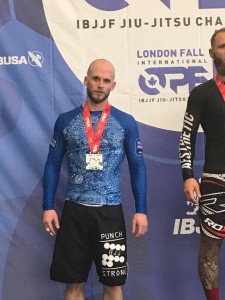We had the pleasure of watching our long time client David perform at the Jiu Jitsu IBJJF event last Sunday, where he finsihed with a superb Silver medal.
We’ve been in charge of designing David’s strength and conditioning program for a couple of years now, so it’s always great to see him in action. Watching his fights live always gives us fresh information on what types of strength work we should prioritise with his training.

Jiu Jitsu requires both mat and standing strength, so the strength requirements are broad and complex. That said, besides the obvious goal of getting stronger here are 3 things we would focus on with an experienced trainee:
1. Training both full range and end range of motion
When you see the positions a Jiu Jitsu fighter find themselves in, you realise that maximising full range of motion strength, especially in the hips, is essential. Practically this means full range squats, high box step ups, glute ham raises, rear foot elevated split squats and back extensions take priority in lower body training. That said there is also plenty of occasions in fights where they have to be explosive in the end range of motion, both in the lower and upper body. Because of this we will cycle in exercises with a slightly limited range, but where he has to overcome inertia such as squats and presses from pins, inverse rows and presses from the floor and pauses during the mid range of a movement.
2. Using a variety of grips
If you’ve ever been to our gym at The Sporting Club you’ll notice straight away that we have a heap of different bars – at least 20 at last count – with many having slightly different grip widths and angles. The grappling nature of Jiu Jitsu means we program A LOT of grip varieties with our exercises – 2 inch grips, tube grips, cone grips, ball grips, pinch grips and towel / belt grips to name but a few.
3. Prioritise both speed and strength endurance
Bands, chains and olympic lift exercises feature heavily in order to teach quick and powerful movements. For less experienced trainees we may program alternative exercises such as kettlebell swings or speed deadlifts which still focus on speed of movement but are less complex. On top of that, a Jiu Jitsu fight goes for 5 minutes without rest, so a fighter needs to be able to reproduce strength and power even when feeling fatigued. Because of this we will train their work capacity by pairing exercises – such as a squat and pull up – whereby you will alternate between the exercises for 5-15 minutes doing as many sets of 2 reps as possible.
